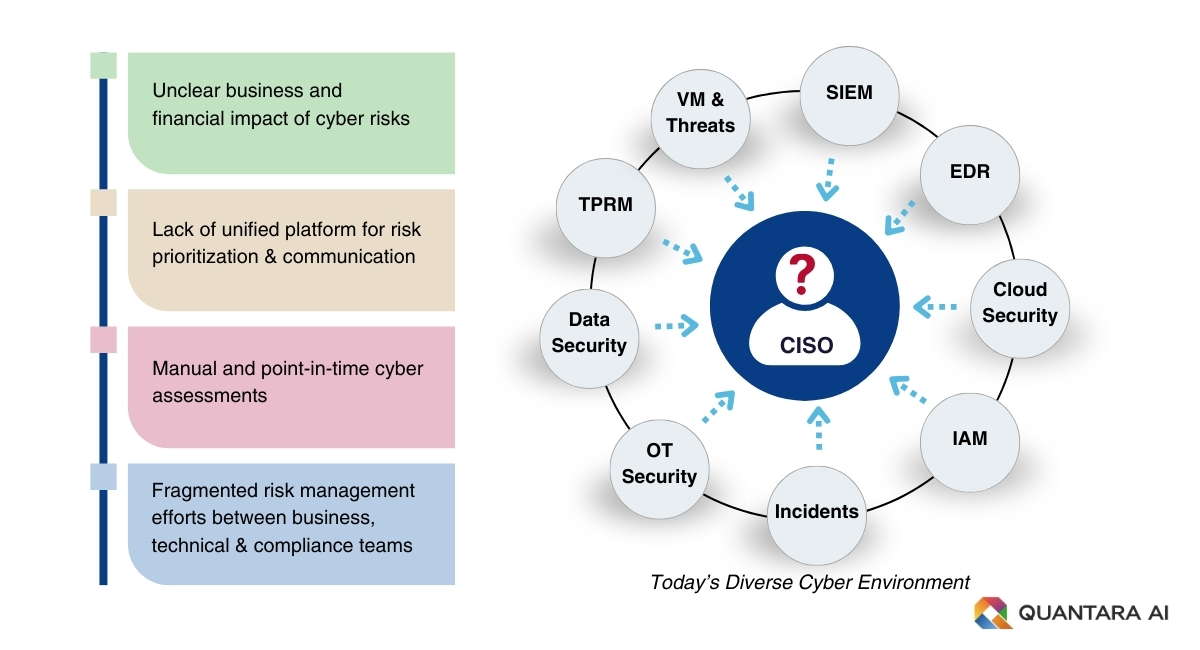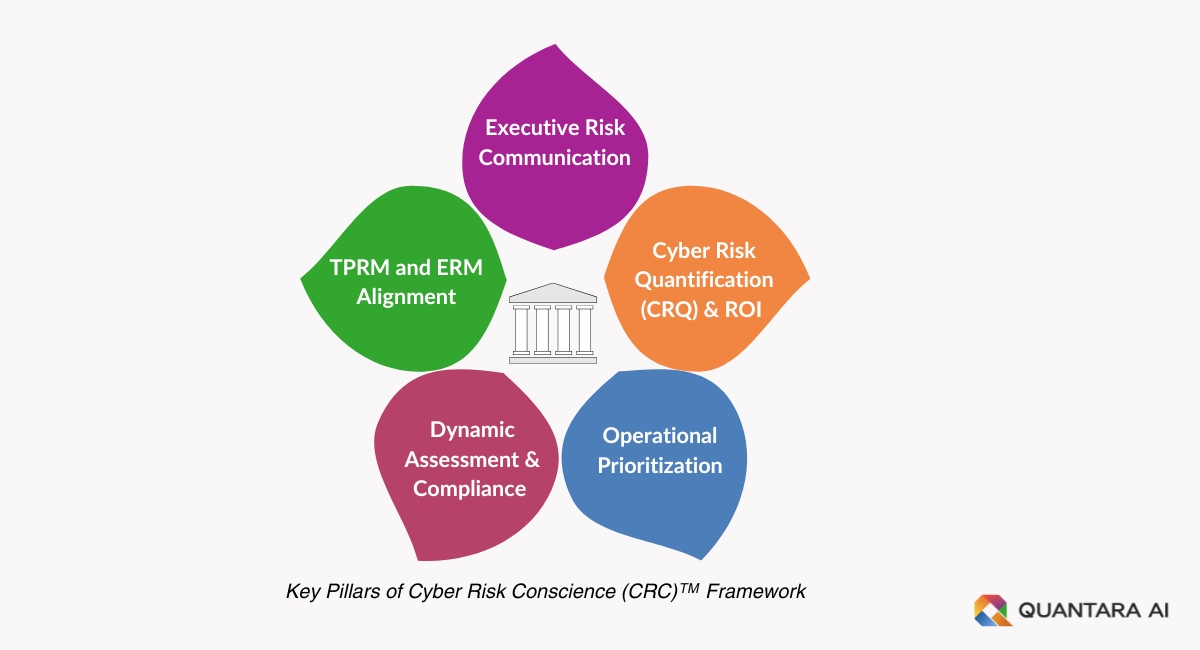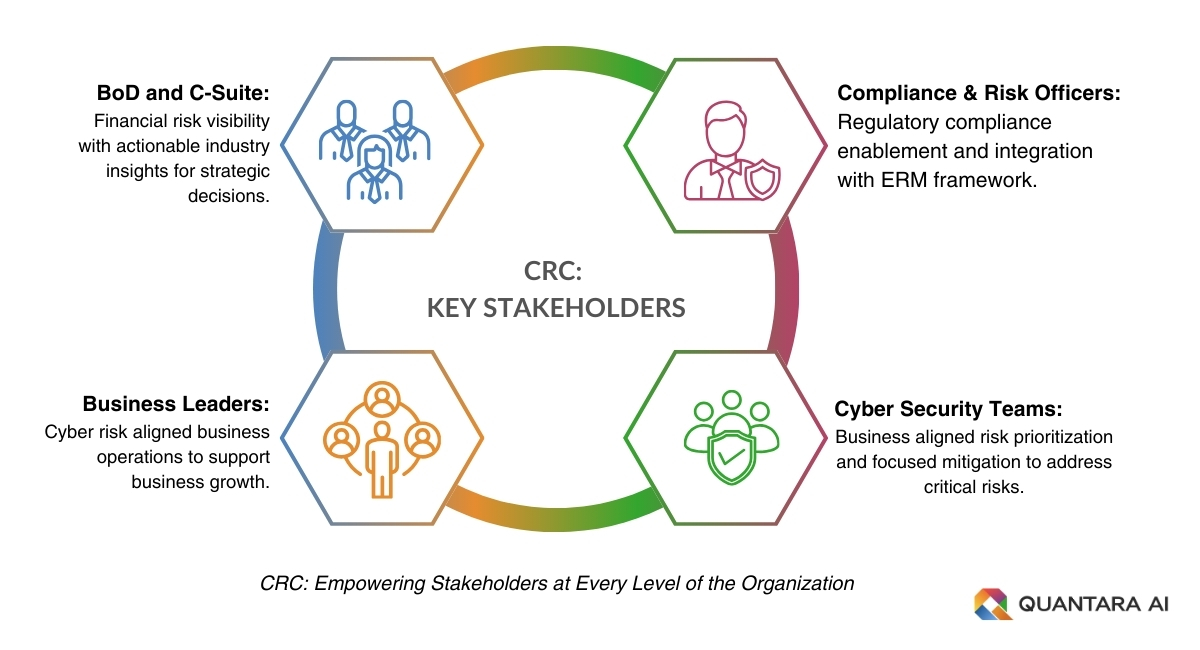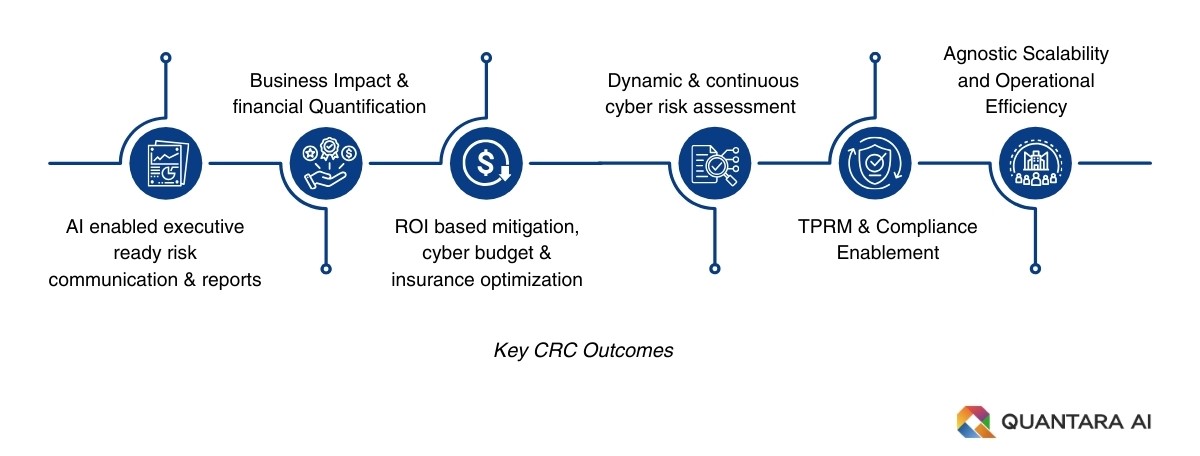Why clear Cyber Risk Conscience (CRC)™ is a Strategic Imperative for Today’s C-Suite

In an era of AI and diverse digital ecosystems, cyber threats have evolved into an empirical risk for organizations. Cyber risk management is no longer just an IT responsibility—it’s a boardroom and C-suite priority. Many organizations struggle to connect their security efforts with their broader business goals. Whether you’re leading a large enterprise or a small-to-mid-sized business (SMB), you likely face challenges like:
- Disjointed Risk Communication: Without a unified platform, prioritizing and communicating risks across teams becomes difficult.
- Limited Financial Visibility: Understanding the business and financial impact of cyber risks remains a struggle.
- Outdated Assessments: Relying on manual, point-in-time assessments leaves gaps and emerging risks unaddressed.
- Misaligned Teams: Fragmented efforts across business, technical, and compliance teams weaken risk management effectiveness.

At Quantara AI, we believe it’s time to reframe how companies approach executive communication and cyber risk management in alignment with business goals. Our clear Cyber Risk Conscience (CRC) framework offers a dynamic, business-aligned approach, transforming cyber risks from an operational burden into a strategic enabler.
What is Cyber Risk Conscience (CRC)™
Cyber Risk Conscience (CRC) refers to the intentional awareness and incorporation of cyber risks into business strategies much like financial, operational, or reputational risks. CRC is the continuous, proactive awareness and integration of cyber risks into business strategy, ROI based decision-making, ensuring that proactive cyber risk management is aligned with business to protect value, trust, and resilience.
In today’s evolving threat landscape, cyber risk management requires more than siloed efforts. Quantara AI’s clear CRC framework delivers an integrated and comprehensive, risk-informed strategy that aligns cyber risk management with organizational objectives. The clear Cyber Risk Conscience (CRC) brings together C-suite, business, IT/cyber and risk leadership, ensuring that cybersecurity and business operations work in tandem.
Each pillar is designed to improve decision-making, streamline processes, and align cyber risk efforts with business outcomes. Below is a breakdown of each pillar:

1. Executive Risk Communication
Cyber Risk Quantification (CRQ) plays a key role in translating risks into measurable financial impact. However, executive risk communication goes beyond financial metrics. Executive leadership also needs timely understanding of external threats and adversarial behavior within their industry. It equips executives with insight into who the adversaries are, their motives, and what industry trends and peer organizations are experiencing. This combination of CRQ and external threat intelligence helps decision-makers anticipate risks proactively.
CRC empowers executive communication by providing financial clarity on risks and insights into adversaries and industry trends, empowering executives to take strategic decisions proactively.
2. CRQ and ROI-Driven Mitigation
With financial insights from CRQ and a deep understanding of adversarial threats, organizations can prioritize ROI-driven risk treatment strategies that deliver the most value. Not all risks carry equal weight, and not all mitigation efforts offer the same return. Rather than applying broad, one-size-fits-all solutions, businesses can target investments toward areas with the greatest risk reduction potential. This approach maximizes the value of cybersecurity spending, ensuring that each dollar invested contributes to meaningful risk mitigation.
CRC enables budget optimization and ROI-driven risk treatment by prioritizing targeted investments with the highest risk reduction potential. Additionally, the CRC framework incorporates scenario analysis to compare different mitigation strategies, showing which option yields the highest ROI based on likelihood of threat reduction and business impact.
3. Operational Prioritization
Once risks are measured with Cyber Risk Quantification (CRQ) and mitigation plans are in place, it’s crucial to focus on the most important risks. This requires teamwork across departments—like IT, operations, finance, and business units—to make sure cybersecurity efforts protect the business without causing disruptions. When teams don’t align, companies often face delays, or missed risks that could hurt operations and long-term goals.
CRC delivers actionable intelligence to align IT, business, and cyber teams, streamlining risk mitigation and enhancing operational efficiency.
4. Dynamic Cyber Assessment and Compliance
Traditional, manual risk assessments often become outdated quickly, leaving organizations vulnerable to new threats. Dynamic, automated assessments provide continuous, real-time monitoring of vulnerabilities, security gaps, and evolving threats. Automation reduces the need for time-consuming manual processes, allowing organizations to swiftly identify risks and address them as they arise.
CRC emphasizes dynamic, automated assessments that monitor risks in real-time. These assessments continuously track security gaps in alignment with cyber frameworks (e.g., NIST, SOC 2, MITRE etc.) to ensure organizations remain agile.
5. TPRM and ERM Alignment
Cybersecurity is increasingly interwoven with Enterprise Risk Management (ERM) and Third-Party Risk Management (TPRM) processes. Aligning cyber risk with these broader frameworks ensures that all organizational risks are managed cohesively, whether they originate internally or through third-party relationships. By treating cyber risk as part of the overall business risk, organizations can streamline risk management strategies and improve resilience across the entire supply chain.
CRC delivers a unified approach to risk management ensures consistency across all areas of the business and with external vendors, reducing exposure to a wide range of risks.
In summary, the CRC framework is imperative for today’s business and cyber governance. CRC delivers:
Interconnected Information Flow:
- Continuous assessments feed real-time data into CRQ and Risk Prioritization.
- CRQ translates data into financial terms, guiding risk prioritization.
Integrated Governance:
- Operational alignment embeds risk management across the organization.
- Compliance enablement ensures regulatory adherence, reducing legal risks.
Strategic, Risk-Driven Decisions:
- TPRM and ERM align internal and external risks with enterprise strategies.
Who Benefits from CRC?
CRC serves stakeholders across the entire organization:
- C-Suite Executives and Board Members: Gain clear insights into the financial impact of cyber risks to guide strategic decisions.
- Risk Managers and Compliance Officers: Ensure regulatory compliance with dynamic assessments and align cybersecurity with enterprise-wide risks.
- Security Teams: Automated risk prioritization based on business goals and focus on high-priority risks.
- Business Unit Leaders: Align cybersecurity with day-to-day operations, driving efficiency and growth.

Whether you’re in finance, healthcare, manufacturing, education, or government, our solution scales to meet your needs, connecting cybersecurity with operational and strategic goals.
How CRC benefits today’s businesses
By ensuring that each pillar supports and informs the others, the Quantara AI’s clear CRC framework delivers business resilience, operational efficiency, cost reduction and strategic growth.

- Proactive Executive Decisions With clear financial insights and industry intelligence, CRC empowers leaders to anticipate threats and make proactive, strategic decisions, keeping the organization ahead of risks.
- Optimized Cybersecurity Investments By focusing resources on the most impactful risks, CRC ensures maximum ROI on cybersecurity spending.
- Seamless Cyber Operations CRC aligns cybersecurity efforts across departments, ensuring critical risks are mitigated without disrupting daily operations, supporting smooth business continuity.
- Continuous Compliance and Agility With real-time, automated assessments, CRC keeps the organization compliant and adaptive to new threats and regulations, ensuring reduced audit risks and penalties.
- Resilient and Unified Risk Management CRC integrates cyber risks with enterprise and third-party frameworks, creating holistic risk management that strengthens resilience across operations and partnerships.
- Scalability and Cost efficiency Quantara AI’s CRC framework delivers scalability across digital environments, personas, industries, and client sizes, while ensuring operational and cost efficiency for secure and sustainable growth
Conclusion: Innovate with Confidence
The future of cybersecurity lies in transforming risk management into a strategic advantage. Quantara AI’s clear Cyber Risk Conscience (CRC) empowers businesses to quantify risks, prioritize investments, align operations, and stay resilient in an ever-changing environment.
It is time to turn cybersecurity from a reactive defense mechanism into a proactive driver of growth and innovation. With Quantara AI, you’ll be ready to secure your future and unlock new opportunities with confidence.
Get Started and Schedule a Demo and discover how Quantara AI can transform your cybersecurity strategy, turning risk management into a strategic business enabler.
Follow Quantara AI on LinkedIn for the latest updates, expert advice, and trends in cyber risk quantification and management. Stay ahead of emerging threats with us!
#CRC #Crq #Cyberriskquantification #Businessriskiq #Bizriskiq #Valueatrisk #Roibaseddecisions #Cybersecurity #AIcybersecurity #Cyberrisk #Quantaraai #cyberriskconscience #CISO #Crcbenefits #SaaS




